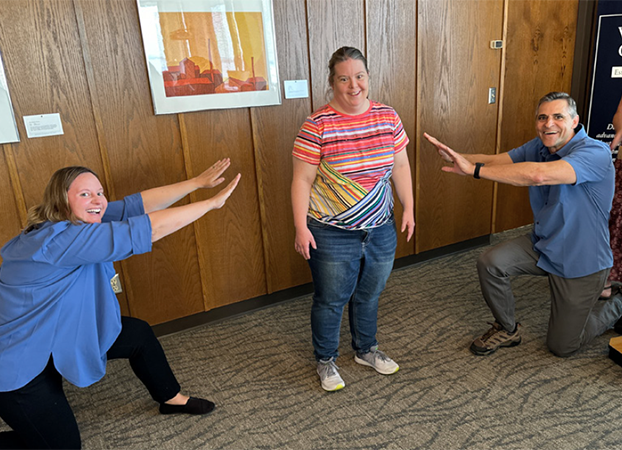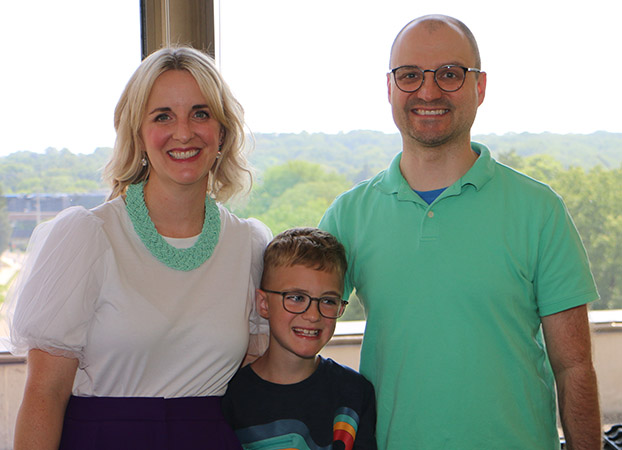
COOL SCIENCE IMAGE WINNER
Matt Zammit, PhD, Waisman scientist in the Brain Imaging Core is a winner of UW-Madison’s Cool Science Image Contest. Zammit’s animation combines 15 years of study PET scans to show where protein plaques most often develop in individuals with Alzheimer’s disease.
The pages of this year’s impact report highlight stories of how we continue our core mission of research, service, training, and outreach.
Download the entire report:

For more than 50 years the Waisman Center has been at the intersection of discovery and hope – forging new paths in research and clinical care. One of our strengths is the diversity and breadth of the research, service, training, and outreach efforts that take place under our roof and extend out to the community.

A Family’s Commitment to Down Syndrome Research at the Waisman Center Spans Four Decades and Counting
When Heather Huismann was in middle school she called the police on her teacher. “He was not teaching me very well,” Heather says. So, she did what her parents taught her to do when there was a problem – stand up for herself. “She called 911 to get her teacher fired,” Larry Huismann, Heather’s father, recalls fondly.

Advising Research through the Lens of Lived Experience
Who is considered an expert in autism? Or cerebral palsy? Or Down syndrome? The word expert is often used to describe someone who has studied a topic extensively, whether through research, through school, or practice. But what about people with lived experiences?

Autism through Midlife and into Older Age
Autistic adults may face changes in their autism symptoms, behavioral functioning, and health as they age, with some
improving and some worsening, a new study shows. This insight may help autistic individuals and their families
prepare and plan for the future.
Read the full story here

Leading by Example: Brooke Mortensen, NP
Brooke Mortensen, NP, always wanted to be a nurse.
“I’ve always enjoyed science but I also love human
interaction and connection. I feel that nursing really
embodies those two spirits equally,” Mortensen says.

CHANGE AHEAD: Transition to Adulthood
Luis “Lui” Montoto’s dream is to open up a food truck where fast food doesn’t sacrifice being healthy, filling, and delicious. He loves being in the kitchen and cooking for his family. He is attempting to get his degree in culinary arts at Madison Area Technical College to become a sous-chef, but has run into a few major roadblocks: not being able to pass a requisite class and a cancer diagnosis. Some aspects of Lui’s transition into adulthood as a man with autism have been bumpy, unusual, and uphill to say the least. And yet, he has pushed forth with the help of one thing that keeps him steady: his family.
Read the full story here

Memory Impairment After Severe Traumatic Brain Injury
Memory impairment as a result of a traumatic brain injury (TBI) has long been associated solely with the hippocampus, the brain’s learning and memory center. However, new research published in the journal Brain Imaging and Behavior, reveals that the hippocampus is not acting alone. The study from the University of Wisconsin-Madison’s Waisman Center, indicates a broader network of brain structures is involved in TBI-induced memory impairment in adolescents.

When Worlds Collide: Autism & ADHD
Felix Benton is a bright and bubbly eight-year-old with
more energy than he or anyone else knows what to do
with. “Fe (Felix’s nickname) likes to say that he has energy
boxes up to Mars,” Felix’s mom, Erin McConnell, says.
Constantly bouncing around and looking for something to
get into, Felix is a ball of love, curiosity, and enthusiasm.
He is currently just a little bit obsessed with engineering
and science and spends a lot of time asking questions about
how things work.
Read the full story here

Taking Out the Trash
Cells make a lot of trash. Probably more than you’d think. So, cells have a trash disposal system that efficiently cleans up and recycles any waste that is produced. But when there are issues with the disposal system and trash builds up in the cell, that can lead to disease. This has led researchers to consider the trash disposal system as a target for potential disease treatments and therapies. New research from the Waisman Center reveals that stimulating a cell’s disposal system in specific places could potentially be an effective treatment route for diseases that are caused by trash accumulation, specifically misfolded proteins.

Improved Assessment Protocols Identify Cerebral Palsy Earlier
Research from the Pediatric Neuromodulation Lab of Bernadette Gillick, PhD, MSPT, PT, at the Waisman Center showcases that evidence-based assessments for cerebral palsy (CP) are helping to improve diagnostic timelines and access to therapies and interventions. These assessment pathways, recommended by clinical guidelines published in 2017, were intended to help facilitate earlier CP diagnoses.

